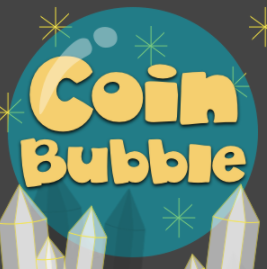
Coin Bubble: A Game’s Worth of Practice

Overview
In this online game, Coin Bubble by Greg Tang Math, students make a given monetary figure using a ten frame of coins. Students work with higher value denominations as the game progresses. In addition, students can use exchanges to get to their figure faster.
Learning Objectives
Students will:
-
Be able to make a given monetary amount using coins and/or bills for numbers less than $20.
-
Be able to use monetary exchanges for both coins and bills to create monetary amounts faster.
Vocabulary
Vocabulary Words:
- Monetary Exchange: A monetary exchange is the use of a different combination of coins and bills to represent the same value.
Pre-planning
To prepare for this lesson:
To prepare for this task, the teacher should:
- Have at least one device per two students that has internet access. The activity will work best if there is a one-to-one device to child ratio.
- Ensure the Coinbubble website is not blocked.
- Watch the tutorial video and/or play the tutorial video for students in a whole-class setting.
Accommodations
See Accommodations Page and Charts on the 21things4students.net site in the Teacher Resources.
Steps
Directions for this activity:
- Watch the tutorial as a whole class or direct students to the tutorial at: https://www.gregtangmath.com/coinbubble
- Have students play the Coinbubble game.
Assessment Options
Different options for assessing the students:
- Observations
- Check for understanding
- To assess a student’s mastery of the concepts presented in this resource, teachers could:
- Have students create a given monetary value using coins and bills.
- Have students create more than one way to represent a given monetary value.
- Have students create anchor posters of the different monetary exchanges.
MITECS Competencies & ISTE STANDARDS
MITECS: Michigan adopted the "ISTE Standards for Students" called MITECS (Michigan Integrated Technology Competencies for Students) in 2018.
Knowledge Constructor
3d. Students build knowledge by actively exploring real-world issues and problems, developing ideas and theories and pursuing answers and solutions.
Computational Thinker
5c. Students break problems into component parts, extract key information, and develop descriptive models to understand complex systems or facilitate problem-solving.
Devices and Resources
Device: PC, Chromebook, Mac, iPad
Browser: Chrome, Safari, Firefox, Edge, ALL
App, Extension, or Add-on:
Websites:
Coinbubble
CONTENT AREA RESOURCES
Math
This activity serves as a precursor to the following standard:
Grade 2 - Measurement and Data
Work with time and money.
CCSS.MATH.CONTENT.2.MD.C.8
Solve word problems involving dollar bills, quarters, dimes, nickels, and pennies, using $ and ¢ symbols appropriately. Example: If you have two dimes and three pennies, how many cents do you have?
Science
Have students research money in other countries and discuss the types and values of the coins and bills that are used and what type of monetary exchanges they have.
Social Studies
Have students create anchor charts of a variety of different monetary exchanges.
CREDITS
This task card was created by Jamila Kai Harris, Shelby Township, MI, March 2020. Updated Nov.2021.


